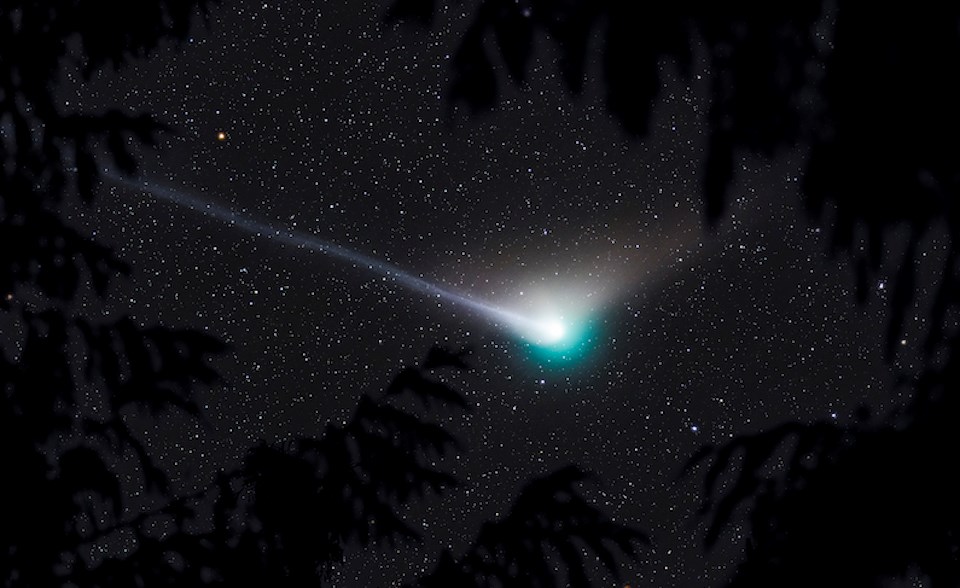Having a passion for deep space and photography isn't all that it takes to become an expert astrophotographer.
But a young, local space enthusiast has also dedicated countless hours to learning the advanced mechanics behind capturing detailed images of celestial objects. The results of his efforts are nothing short of spellbinding, attracting the attention of numerous publications as well as NASA, which featured ."
Liron Gertsman's crystal-clear images may seem effortless -- as if he positioned his tripod at exactly the right moment and captured a quick snap of a breathtaking cosmic event -- but deep space photography is a time-consuming, multifaceted process.
On Wednesday (Feb. 1), Comet C/2022 E3 (ZTF), a rare green-coloured comet that hasn't passed Metro Vancouver skies in a whopping 50,000 years, will make its closest approach to Earth. To put that in perspective, that was approximately the same time that the Neanderthals last walked the planet.
While Metro Vancouverites may be able to spot the comet with the naked eye, it is a good idea to bring binoculars with 40 to 50-mm apertures or a small telescope if you want to be able to make out detail.
What you can and can't see with the naked eye
As Gertsman told Vancouver Is Awesome, the comet doesn't exactly appear the way you might hope it would without some additional help. While he was able to spot it from within the city a few days ago, even with the light pollution, he said it looked more like a star with a hazy glow around it; it was impossible to make out the tail and it did not appear green.
But it isn't because the comet does not have a green hue. Instead, the human eye isn't capable of picking up on the impressive colour in the dark night sky (we aren't nocturnal, no matter how many of us wish we could be).
What makes this comet so interesting, however, is that Gertsman could make out a prominent turquoise colour prior to starting his editing process.
"In a single photo, even without a fancy setup, it looks totally 'turquoise-y' with a basic camera on a tripod," he explained. "That's actually a good way to know that you're looking at the comet because it looks like a star surrounded by a turquoise glow."
What does require some editing is the detail of the "tail." Or, as Gertsman noted, both of the comet's "tails."
"There are two tails visible in photos of the comet: an ion tail, and a dust tail. The ion tail (also called the gas tail) appears as a fairly straight, grey or blue-ish stream of glowing gas being shed from the comet due to solar wind (a stream of particles from [the] sun). So, the ion tail points directly towards the sun," he explained.
"The dust tail is composed of solid particles, shed due to radiation from the sun. The dust tail isn't glowing, rather the solid particles are being directly illuminated by sunlight. The dust tail tends to appear wider (more fan-like) and warmer in colour compared to the ion tail."
The bright turquoise atmosphere of the comet, known as the coma, is also visible. While it may be possible to observe with the naked eye outside of the city, the colour is difficult to observe without a camera.
Capturing the green comet as it passes Earth
Gertsman used more sophisticated tools to produce his final image, including a mirrorless camera with a telephoto lens, a tripod, and a Skywatcher star tracker. The star tracker fits on top of a tripod and allows astrophotographers to follow the stars.
"When you point [the star tracker] at the North Star it rotates at the same rate as the Earth basically or the apparent speed of the sky rotating with the earth. And then that allows me to take really long exposures and reveal a lot of detail in the night sky without getting like streaky stars, which is what happens normally when you don't have the star tracker because we're on a planet that's spinning," he explained.
Gertsman also set up his camera after 2:15 a.m., which was after the moon set on Jan. 29 when he captured the image. He stayed out until about 6:30 a.m. in order to gather enough frames for the final photograph.
The editing process, which took several days, involved a technique called image stacking, where several photos are aligned together and the average value is taken for each pixel.
"It basically creates a much sharper, brighter image [that allows you to see] the details in these tails a lot better than you can in a single image," he noted.
While the Vancouver weather forecast isn't calling for clear skies Wednesday - the night the comet makes its closest approach to Earth - Gertsman underscores that there are several opportunities to catch it in the following days (weather permitting, of course).
The final, jaw-dropping image that he captured near 麻豆社国产was taken roughly three days before the big night, so local space enthusiasts should have an opportunity to capture one that's just as bright in the next week or so.
Follow Gertsman on or check out his photography on his .


